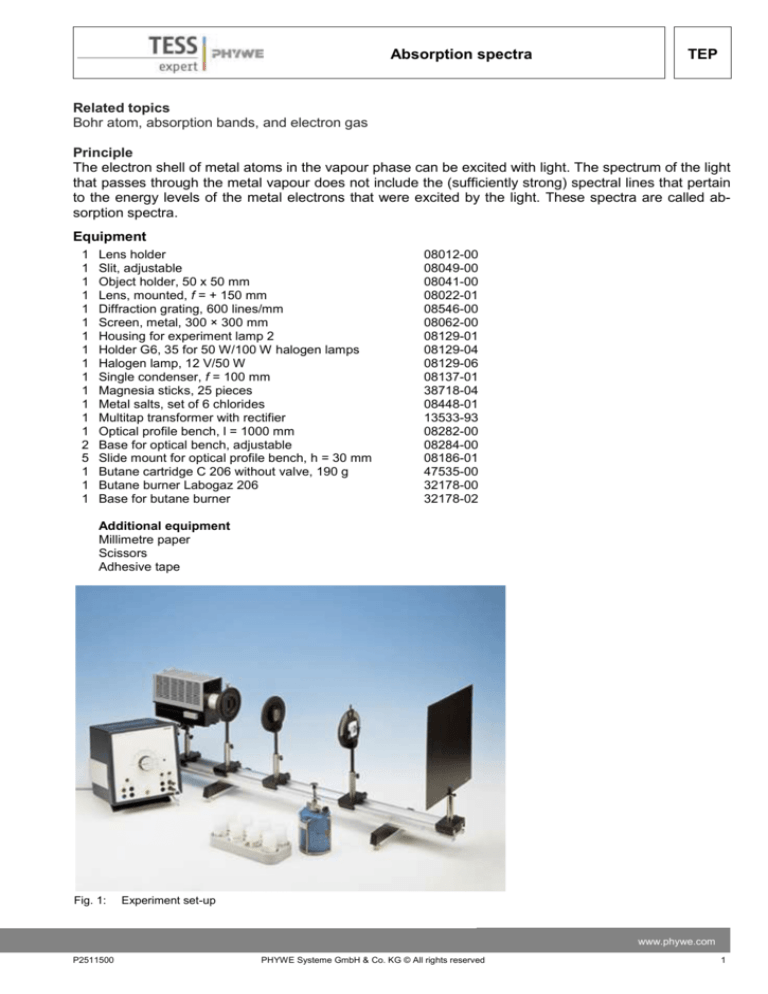
Absorption spectra
TEP
Related topics
Bohr atom, absorption bands, and electron gas
Principle
The electron shell of metal atoms in the vapour phase can be excited with light. The spectrum of the light
that passes through the metal vapour does not include the (sufficiently strong) spectral lines that pertain
to the energy levels of the metal electrons that were excited by the light. These spectra are called absorption spectra.
Equipment
1
1
1
1
1
1
1
1
1
1
1
1
1
1
2
5
1
1
1
Lens holder
Slit, adjustable
Object holder, 50 x 50 mm
Lens, mounted, f = + 150 mm
Diffraction grating, 600 lines/mm
Screen, metal, 300 × 300 mm
Housing for experiment lamp 2
Holder G6, 35 for 50 W/100 W halogen lamps
Halogen lamp, 12 V/50 W
Single condenser, f = 100 mm
Magnesia sticks, 25 pieces
Metal salts, set of 6 chlorides
Multitap transformer with rectifier
Optical profile bench, l = 1000 mm
Base for optical bench, adjustable
Slide mount for optical profile bench, h = 30 mm
Butane cartridge C 206 without valve, 190 g
Butane burner Labogaz 206
Base for butane burner
08012-00
08049-00
08041-00
08022-01
08546-00
08062-00
08129-01
08129-04
08129-06
08137-01
38718-04
08448-01
13533-93
08282-00
08284-00
08186-01
47535-00
32178-00
32178-02
Additional equipment
Millimetre paper
Scissors
Adhesive tape
Fig. 1:
Experiment set-up
www.phywe.com
P2511500
PHYWE Systeme GmbH & Co. KG © All rights reserved
1
TEP
Absorption spectra
Safety instructions
Always wear suitable safety goggles, protective gloves, and safety clothes when handling chemicals.
Please refer to the appendix for detailed safety instructions.
Task
Record the absorption spectra of the metal salts and calculate the wavelengths λ.
Set-up
Set the experiment up as shown in Figure 1.
Use the two adjustable feet for the set-up of the optical bench. Fasten the experiment with the attached
single condenser (f = 100 mm) into a slide mount, and position it at one end of the optical bench. Position the object holder for the grating at a distance of approximately 60 cm. Fasten the screen into a slide
mount at the other end of the optical bench.
Procedure
Project the lamp filament sharply on the screen. Position the adjustable slit directly in front of the lamp
and project a sharp image of it on the screen by way of the lens with f = 100 mm. Attach a small strip of
millimetre paper to the screen at the position of the slit image. Mark the middle of the slit on the millimetre paper. Position the grating in the light path. Position the burner (Bunsen burner) between the grating
and lens. Adjust the height of the burner so that the non-luminous burner flame is infiltrated with the light
of the experiment lamp.
In order to prevent the burner from being contaminated with metal salts, moisten one end of a magnesia
stick with water, hold it in the metal salt, and then put it into the burner flame.
Observe the absorption spectrum, mark the absorbed lines on the millimetre paper, and calculate the
wavelengths λ with the aid of formula (1).
Repeat the experiment with other metal salts.
2
PHYWE Systeme GmbH & Co. KG © All rights reserved
P2511500
TEP
Absorption spectra
Theory and evaluation
According to Bohr's atom model, electrons travel, without radiating, on certain permissible orbits around
the atomic nucleus. Following excitation, they can pass from an orbit of lower energy to an orbit of higher
energy. When an electron jumps back to an orbit of lower energy, it emits the energy ΔE, which it had
absorbed due to the excitation, in the form of a radiation quantum with the frequency f and radiation energy h · f, with h being Planck's constant or quantum of action. The following applies: ΔE = h · f; i.e. the
energy of the emitted quantum equals the excitation energy of a certain energy level.
When metal vapours, for example, are irradiated, the radiation quantums can excite the electrons of the
metal vapour and cause them to pass from a permissible orbit with the energy E1 to another orbit with
the energy E2 if the following is true:
ℎ · 𝑓 = 𝐸2 − 𝐸1
The radiation quantum with the frequency f is absorbed by the electron shell of the metal vapour.
As a result, the spectrum of the radiation lacks precisely those spectral lines that pertain to the excitation energies of the metal vapour. This spectrum is
the absorption spectrum of the metal. It is characteristic of the associated metal.
During this experiment, the absorption spectra of
various metals are analysed. The wavelengths λ of
the absorption lines can be determined with the aid
of a simple grating spectrometer.
If a grating is irradiated with light of various wavelengths, spectra are formed in accordance with the
order of the interference maxima. The spectra are
symmetrical with regard to the direction of incidence
of the light. If the geometrical data of such a grating
spectrometer are known, the wavelength can be calculated directly (Fig. 2). If only the grating spectra of
first order are taken into consideration, the following
results:
Fig. 2: Schematic set-up
𝜆 = 𝑔 · sin 𝛼
𝑙
𝜆 ≈ 𝑔 · tan 𝛼 = 𝑔 · 𝑑.
(1)
Here, g is the grating constant, l is the distance of the first diffraction maximum from the optical bench,
and d is the distance between the grating and the screen.
www.phywe.com
P2511500
PHYWE Systeme GmbH & Co. KG © All rights reserved
3
TEP
Absorption spectra
Dark absorption lines can be observed in the continuous
spectrum of the white light if metal salts are brought into
the irradiated, non-luminous burner flame. The metal vapours that are emitted by the salts absorb precisely those
frequencies from the visible light that pertain to the excitation energies of their atomic shell. This is why the absorption lines are as characteristic as the lines of the emission
spectrum. Table 1 shows several measurement examples.
The colour of the hot burner flame changes when it
comes into contact with a metal salt. This light emission is
caused by the thermal excitation of the energy levels of
the metals due to collisions with the gas molecules.
Note
1. The experiment can also be performed if the wavelengths are determined with a prism spectrometer.
2. It must be ensured that no metal salt falls into the
burner. Otherwise, the burner would be "contaminated"
by the metal salt. In this case, it would be impossible to
adjust a non-luminous flame. The flame would be coloured for a longer period of time.
Table 1: Measurement examples
4
PHYWE Systeme GmbH & Co. KG © All rights reserved
P2511500
TEP
Absorption spectra
Appendix
Hazard pictogram, signal word
Hazard information
Safety measures
H301: Toxic if swallowed.
H332: Harmful if inhaled.
P501: Dispose of contents/container to a recognised waste management facility.
P301 + P310: IF SWALLOWED: Immediately
call a POISON CENTRE
or doctor/physician.
Barium chloride dihydrate
DANGER
Calcium chloride, granular, anhydrous
H319: Causes serious eye
irritation.
ATTENTION
P305 + P351 + P338: IF
IN EYES: Rinse cautiously with water for
several minutes. Remove contact lenses if
present and easy to do.
Continue rinsing.
P501: Dispose of contents/container to a recognised waste management facility.
Lithium chloride
H302: Harmful if swallowed.
H315: Causes skin irritation.
H319: Causes serious eye
irritation.
ATTENTION
P261: Avoid breathing
dust/fume/gas/mist/
vapours/spray.
P302+P352: IF ON
SKIN: Wash with soap
and water.
P305 + P351 + P338: IF
IN EYES: Rinse cautiously with water for
several minutes. Remove contact lenses if
present and easy to do.
Continue rinsing.
P501: Dispose of contents/container to a recognised waste management facility.
Strontium chloride hexahydrate
www.phywe.com
P2511500
PHYWE Systeme GmbH & Co. KG © All rights reserved
5
TEP
Absorption spectra
H302: Harmful if swallowed.
P501: Dispose of contents/container to a recognised waste management facility.
DANGER
6
PHYWE Systeme GmbH & Co. KG © All rights reserved
P2511500









